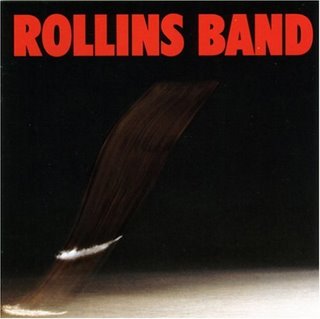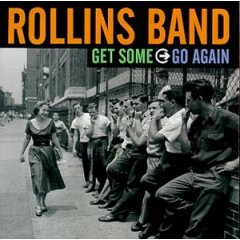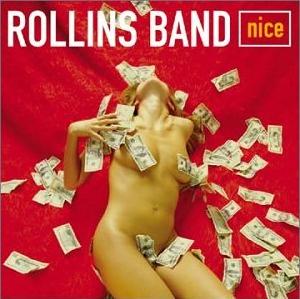
Henry Lawrence Garfield, known professionally as Henry Rollins, is an American singer, writer, spoken word artist, actor, and presenter. After performing in the short-lived hardcore punk band State of Alert in 1980, Rollins fronted the California hardcore band Black Flag from 1981 to 1986. Following the band's breakup, he established the record label and publishing company 2.13.61 to release his spoken word albums, and formed the Rollins Band, which toured with a number of lineups from 1987 to 2003 and in 2006.

Black Flag is an American punk rock band formed in 1976 in Hermosa Beach, California. Initially called Panic, the band was established by Greg Ginn, the guitarist, primary songwriter, and sole continuous member through multiple personnel changes in the band. They are widely considered to be one of the first hardcore punk bands, as well as one of the pioneers of post-hardcore. After breaking up in 1986, Black Flag reunited in 2003 and again in 2013. The second reunion lasted well over a year, during which they released their first studio album in nearly three decades, What The... (2013). The band announced their third reunion in January 2019.

My War is the second full-length studio album by American punk rock band Black Flag. It was the first of three full-length albums the band released in 1984. The album polarized fans due to the LP's B-side, on which the band slowed down to a heavy, Black Sabbath-esque trudge after establishing expectations as a faster hardcore punk band on their first album, Damaged (1981).

Family Man is the third studio album by the American hardcore punk band Black Flag. Released in 1984 through SST Records, it features spoken word tracks by vocalist Henry Rollins and jazz-indebted instrumental tracks. It is also the first album to feature bassist Kira Roessler. "Armageddon Man" is the only track on the album in which Rollins and the instruments are together.

Thin Lizzy are an Irish hard rock band formed in Dublin in 1969. Thin Lizzy initially consisted of bass guitarist, lead vocalist and principal songwriter Phil Lynott, drummer Brian Downey, guitarist Eric Bell and organist Eric Wrixon, although Wrixon left after a few months. Bell left at the end of 1973 and was briefly replaced by Gary Moore, who himself was replaced in mid-1974 by twin lead guitarists: Scott Gorham, who remained with the band until their break-up in 1983, and Brian Robertson, who remained with the band until 1978 when Moore re-joined. Moore left a second time and was replaced by Snowy White in 1980, who was himself replaced by John Sykes in 1982. The line-up was augmented by keyboardist Darren Wharton in 1980. The singles "Whiskey in the Jar" (1972), "The Boys Are Back in Town" (1976) and "Waiting for an Alibi" (1979) were international hits, and several Thin Lizzy albums reached the top ten in the UK. The band's music reflects a wide range of influences, including blues, soul music, psychedelic rock and traditional Irish folk music, but is generally classified as hard rock or sometimes heavy metal.

Undertow is the debut studio album by the American rock band Tool, released on April 6, 1993, by Zoo Entertainment. Produced by the band and Sylvia Massy, it was recorded from October to December 1992 at Sound City Studios in Van Nuys and Grandmaster Recorders in Hollywood. The album includes some tracks the band decided to not release on their debut EP Opiate. This is their only album to feature original bassist Paul D'Amour.
Blind Idiot God is an American instrumental rock trio formed in 1982 in St. Louis, Missouri, United States, by guitarist Andy Hawkins, bassist Gabriel Katz and drummer Ted Epstein. The phrase "blind idiot god" comes from horror writer H. P. Lovecraft's description of the god Azathoth. Their often improvisational musical style combines influences from punk rock, noise music, 20th-century classical music, heavy metal, dub, free jazz, and funk. They are currently based in New York City and have often collaborated with musicians Bill Laswell and John Zorn.
Andrew Weiss is an American musician, composer, audio engineer and record producer.
Chris Haskett is an American guitarist. He was a member of the rock band Rollins Band from 1986 to 1997 and again for the band's reunion in 2006. He has also recorded or performed with David Bowie, Foetus, Pigface, The Cassandra Complex, Tool, The Joy Thieves, and others.

Lizzy Borden is an American heavy metal band formed in Los Angeles in 1983. To date, the band has charted on the Billboard 200 four times. Lizzy Borden is eponymous of the band's lead vocalist.

Weight is the fourth studio album by American rock band Rollins Band, released on April 12, 1994. It featured the band's biggest hits, "Liar" and "Disconnect".

The End of Silence is the third studio album by the American rock band Rollins Band, led by former Black Flag singer Henry Rollins. The album spawned two singles, including the MTV hit "Low Self Opinion". It was their first release to reach the US Billboard 200 chart, and is considered their mainstream breakthrough, with the band having previously released a string of underground albums.

Ricky Warwick is a Northern Irish musician and the lead singer of the rock bands Black Star Riders and Thin Lizzy. He is also the frontman for the Scottish hard rock band The Almighty, with whom he achieved chart success in the UK throughout the 1990s. Warwick has released several solo albums and performed with a variety of other bands and artists, and also fronts his own band, The Fighting Hearts, to showcase his solo material.

Come In and Burn is the fifth full-length studio album by the Rollins Band. Released in 1997 on DreamWorks Records, it is their major label debut. It is also the last album before vocalist Henry Rollins dissolved the band's "classic" lineup of guitarist Chris Haskett, bassist Melvin Gibbs, drummer Sim Cain and sound technician Theo Van Rock. Rollins later formed a new version of Rollins Band with musicians from Mother Superior, who provided his backing band from 1998 until 2006, when the classic Rollins Band lineup briefly reunited.

Get Some Go Again is the sixth studio album by Rollins Band, released in 2000. It is also the first album by lead singer Henry Rollins after dissolving his longtime lineup featuring guitarist Chris Haskett and others. On this album, and its follow-up Nice, Rollins was backed by the band Mother Superior.

Nice is a studio album by the American rock band Rollins Band, released in 2001. It was the Rollins Band's final studio album.

Life Time is the debut studio album by the American rock band Rollins Band, fronted by ex-Black Flag singer, Henry Rollins. The 1987 album was produced by Ian MacKaye. It was reissued in 1999, 2014 and 2021.
"Liar" is a song by Rollins Band and the lead single from their fourth album, Weight, released in 1994. It was the album's only charting single and is one of the group's best known songs.

Melvin Gibbs is an American bass guitarist who has appeared on close to 200 albums in diverse genres of music. Among others, Gibbs is known for working in jazz with drummer Ronald Shannon Jackson and guitarist Sonny Sharrock, and in rock music with Rollins Band and Arto Lindsay.
Punk jazz is a genre of music that combines elements of jazz, especially improvisation, with the instrumentation and performance style of punk rock. The term was first used to describe James Chance and the Contortions' 1979 album Buy. Punk jazz is closely related to free jazz, no wave, and loft jazz, and has since significantly inspired post-hardcore and alternative hip hop.


















